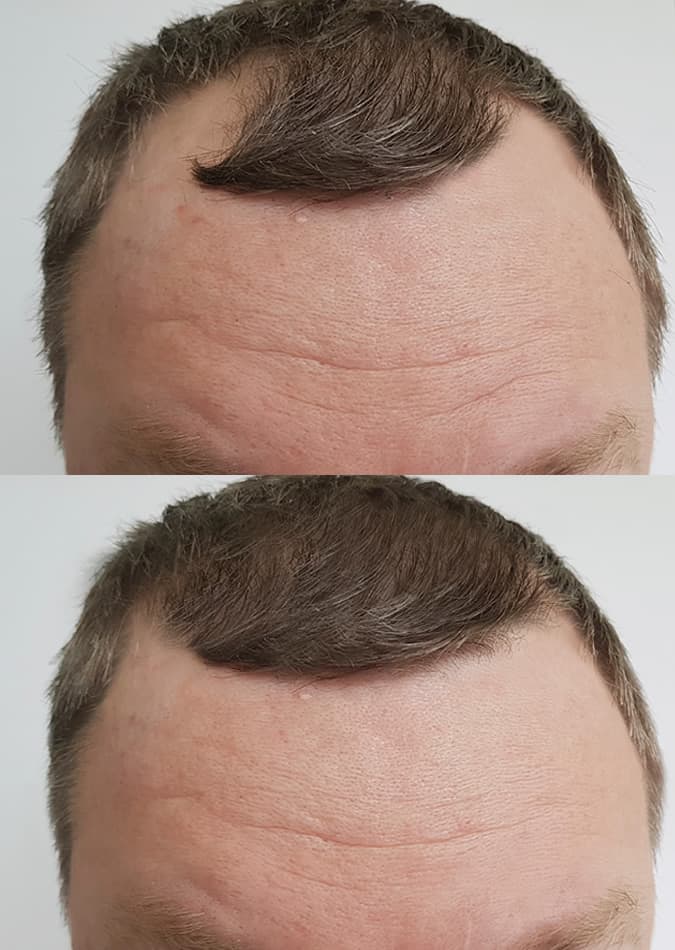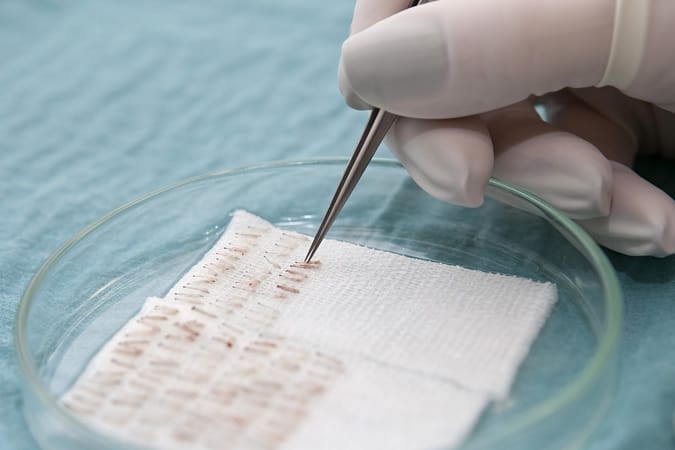Visits: 87
It’s a tell-tale sign we’re getting older. Before the wrinkles come and the back goes, a lot of men start losing their hair strand by strand. Male pattern baldness affects more than half of all men, with one study finding that 53 per cent of us will experience moderate to extensive hair loss by our fortieth birthdays.
For many, that’s a source of anxiety and low confidence, but thinning hair is no longer a foregone genetic conclusion. Hair transplants have become an increasingly accessible, increasingly popular option for the follicularly impaired.
Falling costs and celebrity endorsements (not to mention insistent ads that follow you across the internet) are making more men than ever willing to undergo a surgical procedure, where the hair is effectively taken from where you have it and popped down where you don’t.
“If performed correctly, by a skilful, ethical and experienced surgeon, hair transplants look incredibly natural and undetectable,” says Spencer Stevenson, founder of hair loss advice service SpexHair.com. Stevenson had his first hair transplant at the age of 21, a botched attempt that needed 13 more transplants to correct.
He puts the first effort down to a lack of research on his part and a bad surgeon. “In the wrong hands, they can be disastrous. You’ll never clock a good transplant but you’ll notice a bad one from across the room.”
If you’re thinking of redrawing your receding hairline, make sure you get the good kind with our guide below.

Who Can Have A Hair Transplant?
First things first, do you actually need one or are you just being a tad paranoid? The recommended course of action before taking the severe surgical step is to try a hair loss drug first. Finasteride and Minoxodil are the most popular, with the most evidence behind them and they’re only ones approved by the FDA.
Finasteride works by blocking the production of a hormone called DHT by 60 per cent, DHT being the main reason why we lose our hair. It won’t return previously lost hair but it will stem the tide. Minoxodil in comparison stimulates hair growth but won’t stop current hair loss.
One of the main criteria for considering a hair transplant is making sure the supply will meet the demand. “If the donor region (the supply) is small and the top (the demand) is large, it doesn’t make for an ideal hair transplant candidate,” says Stevenson. “These cases tend to be quite rare, but extensive balding patterns tend to exclude patients form surgery.”
Surgeons will use the Norwood scale to determine your level of loss in this regard. There are eight levels to the scale, the first being minimal while the last is the most severe with little hair on the front or top. If you’re at this final stage it might be best to accept your fate.
Course or wavy hair will grant more coverage and better density than finer hair, so tends to suit a transplant best as does a looser scalp which makes it easier for your surgeon to plant in the follicles.
There is no minimum age for a hair transplant, but do consider that the younger you are the more likely you will need another transplant in the future as your hair loss continues.

The Options: FUE vs FUT
The two most popular and common types of hair transplant are FUE and FUT. The latter stands for follicular unit transplantation and involves the surgeon taking a strip of hair follicles from the supply (i.e. where you have hair) and then positioning them into incisions in the scalp where there is a demand (i.e. where you need hair). The scalp is then sewn up at the back with the hair around it hiding the patch.
FUE or follicular unit excision is more fiddly for the surgeon but far less invasive and painful for you, the patient. It requires the practitioner to shave the back of your hair before then taking each healthy hair follicle individually and inserting them into tiny cuts in the scalp where the hair is thinning or receding.
The Procedure
“The FUE procedure leaves no visible scarring at the back of the head, as was the case with older strip methods of hair transplant,” says Dr. Raghu Reddy, hair transplant surgeon at The Private Clinic of Harley Street. “Patients can leave the clinic immediately after treatment with minimal downtime, so they’re able to quickly get back to their day to day activities.”
Carried out under local anaesthetic, you will be fully awake while the transplant is happening. You may have to wear bandages over your scalp as it recovers and require one or two days off work (take more if you don’t want nosy colleagues asking questions). After the procedure, your scalp will feel tender to the touch and there will be some discomfort as the anaesthetic wears off, but nothing a few prescribed painkillers won’t manage.

“It doesn’t hurt at all,” says Stevenson. “I’ve had 13 and have a low pain threshold, so I’m a good judge. It’s more uncomfortable, sitting in the chair for an extended period of time. It’s like getting a filling at the dentist, in terms of pain but over a much longer time period. You can be in the chair from five to 12 hours, depending on the procedure.”
Do note that smaller patches of hair can take up just two to three hours of your time, according to Reddy. You may need more than one session but these will be spread apart so your scalp can recover in between. As long as you have the supply of hair coming through you can have as many transplants as you like.
What Results Can You Expect?
The ceiling of the Sistine Chapel didn’t appear overnight, and nor will a glorious new mane of hair. Immediately after the procedure your scalp will look less like a Michelangelo and more like a pointillist painting with tiny red scabs appearing around the newly inserted follicles. After a few days you can take the bandages off and gently wash it, and after a week the red dots will have disappeared and you should already have some short coverage.
Tempted by a hat to cover up the scarlet blobs? Don’t. Any sort of headwear might apply pressure onto the grafts, moving them out of place in the process. You need to wait for the new follicles to permanently settle into their new position.
After a month your newfound transplanted hair might start falling out but don’t panic. It’s simply the new hair at the root pushing through the donor hair. From six months you should expect the majority of the hairs to have grown through and after a year the full results should be visible.
Et voila, you finally have your hairline back.
But what will it really look like at the end? Well, the precise nature of the advanced FUE procedure means skilled surgeons are able to insert the hairs at a specific angle. This mimics the natural direction of your normal hair, not always a given with FUT, producing a mane of hair as natural looking as that which God gave you.
The limited scarring at the back from FUE will make shorter styles easier, whereas you’ll likely want a medium-length hairstyle after FUT to cover up the slight scarring that will likely leave behind.
“It won’t be as thick as it was when you were 18 years old,” says Stevenson, “but you’ll have styles available for you to choose from and options for haircuts.”

Are There Any Side Effects?
In terms of surgical side effects, infection from the procedure can happen but is very rare. “The incisions are so small the risk of post-operative infection is very low. I have never had a patient who has experienced infection,” says Reddy.
“Although very rare, patients should also be aware of the risk of shock loss, when the patient’s natural hairs fall out due to the trauma of the procedure. This can occur when the number of incision sites is too high, the incisions too big or too deep. Using too much anaesthetic can also contribute to shock loss.
“I also see lots of patients who come to me as they are unhappy with the results of procedures that they have had elsewhere. Some of these side effects include donor depletion, caused by taking too much hair from the donor area, grafts placed in bad angles, poor texture of transplanted hair and unnatural hairlines.”

How To Find A Good Clinic
The latter side effects make it imperative you pick a trusted and responsible clinic and surgeon in the first place. “I’d recommend searching for an IAHRS.org screened surgeon as a good, solid starting point,” says Stevenson. If you’re in the UK, look for a clinic that is registered with the Care Quality Commission, the UK’s regulatory body for healthcare procedures.
Shop around and meet more than one surgeon before settling for the one. Think of it like your hitting the dating scene only instead of your heart, you’re committing the future of your hair.
Research your surgeon thoroughly. Look carefully at pictures of their work. Reach out on hair loss community boards for recommendations of surgeons from people who’ve had a transplant. The more information you have to hand about the person your committing your scalp to the better.
Reddy also stresses you check that the surgeon has a stable team they work with day in, day out around. Like any team, they’ll get better the more they play together.

How Much Does A Hair Transplant Cost?
The big question. Well, of course, it all depends on who you get to do it, where you go (London tends to cost more) and the extent of the job at hand.
The ballpark figure for a FUT procedure is anywhere between £3,000 and £7,000. FUE is more expensive and usually charged at a cost per follicle. So, for an average procedure of 2000 follicles, you might be charged at £5 each taking the total to £10,000, with a decrease in price for any follicles over 2,000.
Pricey, heh? Now, we tread lightly here, but, there is another, increasingly popular, option – a trip to Turkey. A reported 5,000 visitors land in the country every month with the sole goal of getting a hair transplant between hot air balloon rides and a dash around the Grand Bazaar.
Hair transplants in Turkey average out at around £1,500, a sizeable chunk less than back in the UK. You can get great service out there but a deeper level of research is of the utmost importance with the main worry being the lack of regulation in a country which has been criticised for failing to prevent a number of illegal transplant activities.
Go online and you’ll find many a happy customer. For Stevenson, however, it’s not worth the risk, and the cost to repair any botched transplants would far outweigh the saving you may make at the beginning. “Surgery lasts a lifetime, so you need to get it right first time around,” he says.
/**/Continue Reading

